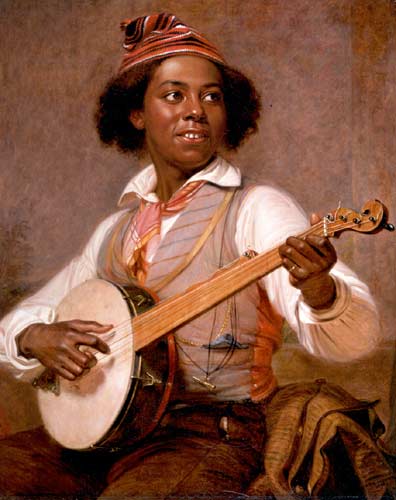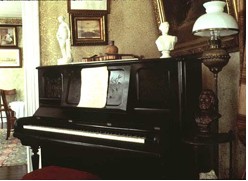White into Black: Seeing Race, Slavery, and Anti-Slavery in Antebellum America
Sarah L. Burns, Indiana University
Joshua Brown, The Graduate Center, CUNY
Slave or Free?
Like Jocelyn’s portrait of Cinqué, many nineteenth-century portraits were more than “true likenesses”: portraits of well-known individuals often served as public performances conveying messages about the subject’s position in society to the people who viewed them on gallery walls or as commercial prints in their own homes. These messages could be found in the subject’s expression, in the direction of his or her gaze, in the subject’s posture, in the clothes she or he wore, or in the setting surrounding the subject.
Figure 15: Unknown photographer, Portrait of a Man. Daguerreotype, 2 11/16 x 2 3/16 inches, c. 1854. Source: The J. Paul Getty Trust, 84.XT.441.11.
Use the slider to zoom in and out of the image
Figure 15: Unknown photographer, Portrait of a Man. Daguerreotype, 2 11/16 x 2 3/16 inches, c. 1854. Source: The J. Paul Getty Trust, 84.XT.441.11.
Use the slider to zoom in and out of the image
Look at this daguerreotype photograph (Figure 15) of an unknown gentleman. How do you think he wanted to be seen? Can you determine his social class through his image? How do individual details communicate his social status?
Who controlled the messages in such portraits—the artist or the sitter? This question had special meaning for notable African Americans who could expect their faces to appear in many different types of publications with very different views about slavery and equality. The former slave and leading abolitionist Frederick Douglass was outspoken about this issue.
First: Read this excerpt from an article by Douglass published in the April 7, 1849 edition of his newspaper The North Star
Negroes can never have impartial portraits, at the hands of white artists. It seems to us next to impossible for white men to take likenesses of black men, without most grossly exaggerating their distinctive features. And the reason is obvious. Artists, like all other white persons, have adopted a theory respecting the distinctive features of Negro physiognomy. We have heard many white persons say, that ‘Negroes look all alike,’ and that they could not distinguish between the old and the young. They associate with the Negro face, high cheek bones, distended nostril, depressed nose, thick lips, and retreating foreheads. This theory impressed strongly upon the mind of an artist exercises a powerful influence over his pencil, and very naturally leads him to distort and exaggerate those peculiarities, even when they scarcely exist in the original.
Second: Examine this portrait of Douglass (Figure 16) published in A Tribute for the Negro, an 1849 book edited by Quaker abolitionist Wilson Armistead that chronicled the achievements of Africans and African Americans:
Figure 16: Unidentified artist, Frederick Douglass. Wood engraving, Wilson Armistead, A Tribute for the Negro: Being a Vindication of the Moral, Intellectual, and Religious Capabilities of the Colored Portion of Mankind; with Particular Reference to the African Race (Manchester and London, 1848), 457. Source: UNC Library, University of North Carolina at Chapel Hill
Use the slider to zoom in and out of the image
Figure 16: Unidentified artist, Frederick Douglass. Wood engraving, Wilson Armistead, A Tribute for the Negro: Being a Vindication of the Moral, Intellectual, and Religious Capabilities of the Colored Portion of Mankind; with Particular Reference to the African Race (Manchester and London, 1848), 457. Source: UNC Library, University of North Carolina at Chapel Hill
Use the slider to zoom in and out of the image
Taking into account Douglass’s comments about portraiture, what is your impression of this picture? What message do you think this portrait conveyed? Sharing your ideas in a group discussion, point out the details of the portrait that you think are important in conveying that message.
Third: Now, consider Douglass’s reaction to this particular published portrait. His comments about it were brief and not complimentary. “The book would have been better without them,” he wrote in The North Star, referring to all its portraits. As for his own picture, he wrote: “[I]t has a much more kindly and amiable expression, than is generally thought to characterize the face of a fugitive slave.”
Does Douglass’s response surprise you? Why would the book have been better without portraits? What do you think he meant by his last remark? Discuss what aspects of the portrait might have been different to change Douglass’s mind.
Now compare the Douglass portrait with another portrait, The Banjo Player, painted in 1856 by the New York artist William Sidney Mount (Figure 17):
Figure 17: William Sidney Mount, The Banjo Player. Oil on canvas, 35 3⁄4 x 28 3⁄4 inches, 1856. Source: The Long Island Museum of American Art, History and Carriages, Stony Brook, New York. Gift of Mr. and Mrs. Ward Melville, 1955.
Use the slider to zoom in and out of the image
Figure 17: William Sidney Mount, The Banjo Player. Oil on canvas, 35 3⁄4 x 28 3⁄4 inches, 1856. Source: The Long Island Museum of American Art, History and Carriages, Stony Brook, New York. Gift of Mr. and Mrs. Ward Melville, 1955.
Use the slider to zoom in and out of the image

The name of his model is lost to history, but we do know that the artist painted this image from life. The original was reproduced as a popular print that sold widely in the United States and Europe.
Using your cursor, explore the portrait and its details and read the accompanying information.
After examining the details and annotations, describe what you think Mount’s message was about this individual’s social and political status in society. Can you tell from the way Mount portrays him that this man was a free northern black rather than a slave? Do you think that the banjo player was in control of his image, or not, and why? How does this image affect your attitude to Douglass’s comments about the ways white artists portrayed black people?
Now compare the portrait in A Tribute for the Negro and Mount’s The Banjo Player with a photographic portrait that Douglass commissioned himself (figure 18):
Figure 18: J. C. Buttre, Frederick Douglass. Wood engraving, Frontispiece, Frederick Douglass,My Bondage and My Freedom (New York, 1855). Source: Rare Book Collection, Wilson Special Collection Library, University of North Carolina at Chapel Hill.
Use the slider to zoom in and out of the image
Figure 18: J. C. Buttre, Frederick Douglass. Wood engraving, Frontispiece, Frederick Douglass,My Bondage and My Freedom (New York, 1855). Source: Rare Book Collection, Wilson Special Collection Library, University of North Carolina at Chapel Hill.
Use the slider to zoom in and out of the image
This portrait appeared as the frontispiece engraving in the 1855 edition of his autobiography My Bondage and My Freedom. (It had to be rendered as an engraving because photographs could not yet be reproduced in print.)
Examine the details of this photographic portrait. Keep in mind Douglass’s comments about white artists and black subjects as well as Douglass’s reaction to the earlier portrait.
Consider why Douglass would want to present himself in this way, and how you think he acted to control his own image and message. Click here to provide your answers in the text boxes. Refer to specific features of the portrait.
- How is Douglass holding himself?
- In what direction is his head and torso turned?
- What is Douglass doing with his eyes and mouth?
- Do his clothes affect his overall appearance?
- Are his hands part of his message?
Third: Share your comments with others. Then, in a group discussion, reflect back on the other antislavery images you have viewed over the course of this exercise. Consider the different media (from statues, to cartoons, to paintings, to prints, to photographs) and how they affect or shape their meanings. Also take into account the direct and less obvious messages in each image: choose two that you feel had the greatest impact on their viewers and explain why. How were the images used to promote social and political change? In addition, take into account the relationship between the artist and the subject of each image. And you should draw some conclusions about the effectiveness of Douglass’s portrait strategy.
Finally, here’s a link between The Greek Slave and Douglass’s My Bondage and My Freedom portrait. . .
We’ll close with two photographs. The first picture (Figure 19) shows the west parlor of Cedar Hill, the house in the District of Columbia that Douglass called home from 1878 until his death in 1895. The second photograph (Figure 20) shows Douglass at his desk in Haiti where he served as U.S. minister from 1889 to 1891.
Look carefully at each photo. Do you notice anything of significance there?

Figure 19: Piano, West Parlor, Cedar Hill. Source: Frederick Douglass National Historic Site, FRDO 45
Figure 20: Unknown photographer, Frederick Douglass at desk in Haiti. Source: Frederick Douglass National Historic Site, Catalog Number: FRDO 3899.
Use the slider to zoom in and out of the image
Figure 20: Unknown photographer, Frederick Douglass at desk in Haiti. Source: Frederick Douglass National Historic Site, Catalog Number: FRDO 3899.
Use the slider to zoom in and out of the image
Why do you think he chose to display it? What meanings do you think he perceived and valued in this figure?
